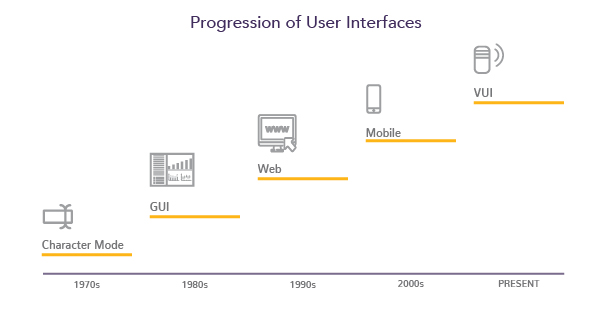The success of voice-enabled personal assistants is ushering in the next disruption in business computing: Voice User Interface or VUI.
It’s a good time to be a computer scientist. In the last 25 years, our field has seen unimaginable growth.
Think about the innovations that have been introduced during this time:
- Graphical User Interfaces
- World Wide Web
- Smartphones
- Cloud computing
The pace of innovation continues at break-neck speed, with each new innovation coming to market faster and disrupting industries that have been around for decades.
And we are at an inflection point with one such disruptive technology: Voice.
Future of Voice Recognition
Voice recognition has existed for years, with varying levels of success. By now, we’ve all had the frustrating experience of interacting with interactive voice response (IVR) systems on the telephone.
More recently, voice technologies like Amazon Alexa, Apple Siri, and Google Home have made their way into our personal lives, helping us find directions, turning on the lights in our home, and playing our favorite music simply by using our voice.
The success of voice-enabled personal assistants is ushering in the next disruption in business computing: Voice User Interface or VUI.
The graphic below shows the progression in user interfaces starting in the 1970s to the present (2018):
- Character Mode (using a keyboard)
- Graphical User Interface (using a mouse and keyboard)
- Web (using a browser and a mouse)
- Mobile (using a smartphone and your finger)
- Voice User Interface (using your voice)
The progression of user interfaces from keyboard, mouse, touch and voice has made the process of interacting with computers much simpler and intuitive. Voice is no different: allowing users to initiate simple conversations with a computer as if he or she was speaking with a friend or family member.
However, making this interaction natural and intuitive is NOT simple!
Users can quickly become frustrated with poorly designed voice user interfaces (think about IVR telephone systems.) Designing and implementing VUI requires new ways of thinking about how your organization interacts with customers, employees and business partners.
VUI technologies have reached a point where understanding the user’s words is a given. But understanding intent (what the user wants the computer to do) is what makes or breaks the user experience.
Final Thoughts on Voice Technologies
The technologies that succeed in this new frontier will be the ones that can quickly and correctly understand a user’s intent and carry out the action(s) appropriately.
I can’t wait for the day when I can ask Alexa to write my next blog!

